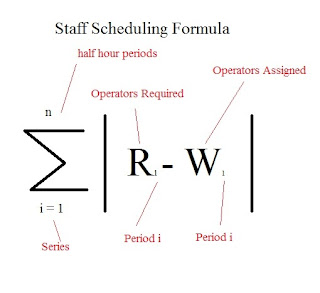Proper staffing, customer comfort, and operational
effectiveness is important for creating strong service delivery. With proper
staffing organizations can covered needed service and production aspects of
running the business. All operations should have in mind the customer needs as
they are going to be purchasing the products and services. This requires the
ability to move customers efficiently and quickly throughout the organization
without reducing the potential for future purchases. Likewise, the method of
effectively improving slow spots in service and operations can be found using a
critical path map or analysis.
Projection and Staffing:
Management has the responsibility to ensure that
workers are covering the required volume of production in order to meet demand.
The scheduling of the workers is an important function of management and can
lead to all types of efficiencies or inefficiencies in labor costs. To do this
well managers often project or forecast demand. It is possible to create
efficiencies in scheduling using a formula:
The sum of half hour increments times (number of
operators required minus the number of operators assigned in a period). It is beneficial
to see the staff scheduling formula below.
The purpose of such a formula is to reduce the
amount of waste in schedules as often seen in organizations that suffer from
higher labor costs. The more efficient a manager can project need and schedule
accordingly the less cost to the product or service and more profit that can be
made. However, one doesn’t need to get this complex to have strong staffing. Staffing
is primarily concerned with effective coverage despite the methodology.
The key is to balance the need for full-time and
part-time employees in order to ensure that all of the needs of the
organization are being met. Part-time workers come with advantages in terms of
cost but are also limited in their knowledge and commitment to the
organization. Therefore, full-time workers often make up a larger percentage of
the employees due to their institutional and career knowledge.
Waiting Lines:
Waiting lines create problems for companies. As
people wait they become annoyed by the inactivity. This inactivity not only
reduces the perceived quality of the service but it stops customers from
shopping, buying products, or browsing which leads to higher sales. It also
holds up organizations that could better put their time toward serving other
customers. A number of methods can be used to deal with the frustration of
waiting in line (Fitzsimmons & Fitzsimmons, 2010):
Animate: Keep waiting fun.
Discriminate: Offer preferred services
Automate: Simple problems and questions can be
automated.
Obfuscate: Reduce the perception of wait time.
Critical Path Method:
The critical path method offers an opportunity to
determine the start and finish times for certain projects. It also may be used
to determine the activities and paths of services and customer actions. The
basics of the path method are (Armstrong-Wright, 1969):
1.) A
list of all activities required to complete a project.
2.) The
time that each task takes to complete
3.) The
relationships between the activities.
When outlined it is possible to use such methods to
determine the amount of time, resources, and staffing needed for activities. It
provides for a mental schematic for people who want to see how customers are
moving and areas where there may be regular service delays. For example, if an
analysis has shown that consistent service delays are occurring at a particular
node it may be necessary to adjust, divert, or offer additional support to the
path.
Armstrong-Wright, MICE,
A. T. Critical Path Method: Introduction and Practice. Longman Group
LTD, London, 1969
Fitzsimmons, J. & Fitzsimmons, M. (2011). Service
Management: Operations, Strategy, Information Technology (Seventh Edition).
NY: McGraw-Hill.


No comments:
Post a Comment